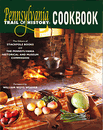Food Preservation
This article originally appeared in Pennsylvania Trail of History Cookbook
Before the days of mechanical refrigeration, preservation of food was a time-consuming process that required considerable ingenuity, as well as the proper storage area or building. In many early homes, storage was found within the house. Hope Lodge, in Fort Washington, Montgomery County, features a root cellar - a shuttered cool and dry room - for storing potatoes, carrots, and other vegetables. The house also has a meat cellar with a plastered ceiling to keep odors from rising to the floor above and a dairy cellar with a trough that held running water around three sides to cool the room through evaporation.
Other homes had separate springhouses, such as the one found at Conrad Weiser Homestead. The stone building was constructed on top of a spring, whose cold, clear water was used to chill perishable food items. At the Daniel Boone Homestead, the spring is found in the basement of the house - the foundation walls of the original Boone home - where the family used it as both their water source and a place to keep dairy products in earthen crocks immersed in the water. Although ice storage was not common in the seventeenth century, Pennsbury Manor's reconstructed icehouse almost certainly was stocked with sawdust-packed ice from the nearby Delaware River during the winter months.
When long-term preservation - particularly of meats or fish - was necessary, salt curing or smoking was employed. Smokehouses such as those at Pennsbury Manor and the Daniel Boone Homestead were constructed to smoke beef and pork. Meat hung from the joists, and a hickory or applewood fire was built on the dirt floor. Sawdust or leaves were heaped on the flames to produce smoke, which billowed out through the cracks and eaves of the smokehouse. It took about two weeks to smoke the meat during which time the fire needed constant tending.
Although a method for canning foods was developed in the eighteenth century, home canning was not widespread until John Mason patented his glass canning jar in 1858. Canning provided a means for storing meats, vegetables, fruits, and preserves over an extended period of time with little risk of spoilage. In many coal towns and mill towns, home gardens were sources of food not controlled by the company stores, and canning provided a means to extend the harvest. Canning experienced a revival during World Wars I and II, when victory gardens flourished and housewives sought ways to stretch the yield of their plots as far as possible. One poster of the period urged, "Can all you can. Food thrift - your patriotic duty."
Visit
Hope Lodge, Fort Washington, PA
Temporarily closed to the public.
Conrad Weiser Homestead, Womelsdorf, PA
Discover the Colonial diplomat, who kept peace with the Iroquois Confederacy.
Daniel Boone Homestead, Birdsboro, PA
The homestead includes the Boone House, restored and furnished with period collections.
Pennsbury Manor, Morrisville, PA
The country estate of Pennsylvania's founder, William Penn.
For Further Reading
 |
Pennsylvania Trail of History Cookbook Edited by Kyle R. Weaver, Diane B. Reed, and Fred Lauver Forward by William Woys Weaver Stackpole Books and Pennsylvania Historical and Museum Commission 2004 |
 |
Hope Lodge: Pennsylvania Trail of History Guide by Lorett Treese Stackpole Books and Pennsylvania Historical and Museum Commission 2001 |
 |
Conrad Weiser Homestead: Pennsylvania Trail of History Guide by John Bradley Stackpole Books and Pennsylvania Historical and Museum Commission 2001 |
 |
Daniel Boone Homestead: Pennsylvania Trail of History Guide by Sharon Hernes Silverman Stackpole Books and Pennsylvania Historical and Museum Commission 2000 |
 |
Pennsbury Manor: Pennsylvania Trail of History Guide by Larry E. Tise Stackpole Books and Pennsylvania Historical and Museum Commission 2002 |



